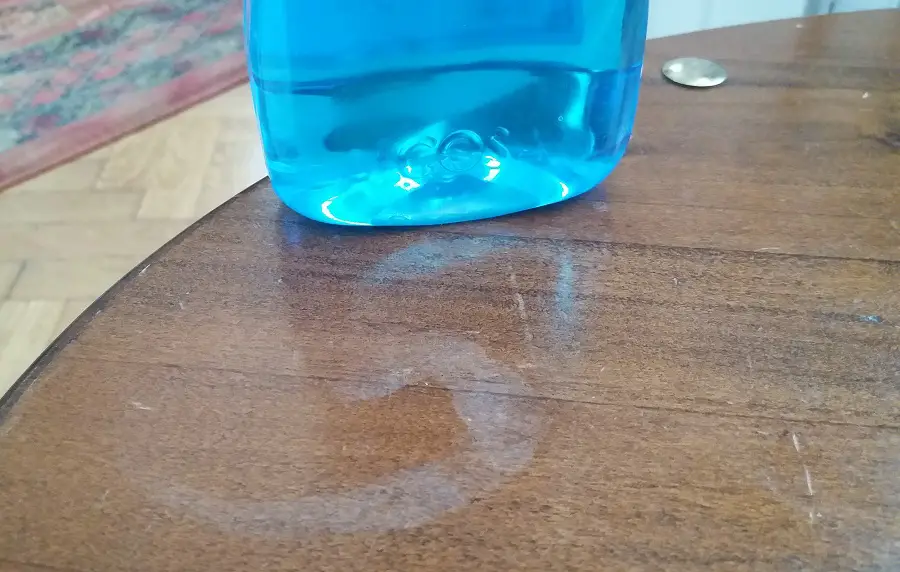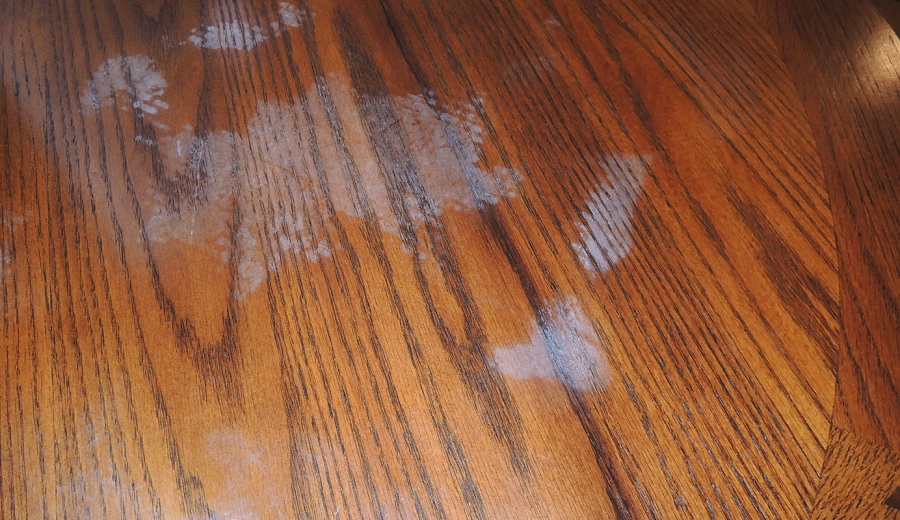These days we are often told to disinfect the surfaces we come into contact with as often as possible. The recommended substances are those based on alcohol or chlorine derivatives, in particular sodium hypochlorite (laundry bleach). I have received messages asking what to do if, after disinfecting, some pieces of furniture or doors have turned white. I even saw this question on a profile group. So it's a topic of interest and that's why I think the below may be helpful.

Why do surfaces whiten
Furniture and doors will whiten if they are wiped with a spirit-based substance. These are lacquered objects. Spirit is a solution of ethyl alcohol, which is part of the lacquer thinner. When you wipe the surfaces, the varnish softens and allows air and water (from the disinfecting mixture) to get inside the film. Hence the white color. The rapid evaporation of the alcohol causes the varnish to harden again and the air and small particles of water remain trapped inside.
The attack of alcohol on surfaces can be different, depending on the concentration and how long it has been on the surface. If the solution is very dilute (1:3 medicinal spirit in water) or the spirit has had brief contact with the surface, the surface will be very little affected, but disinfection is not effective. Bleaching furniture is only superficial and the marks look like white clouds in the film or white shadows on the surface. Over time the marks will fade and if they are just light white shadows, they will disappear.
When the disinfectant is concentrated (I've seen the recommendation to use 60-65° alcohol) and the alcohol sits on the surface for a while, the traces are very visible. The traces are deep white and crumbly. In this case the varnish has been dissolved and because the drying has been rapid, the appearance is similar to gassed film (when dried drops of varnish fall on the still wet film). The film does not recover over time and the surface has to be repaired.
Repairing very lightly damaged areas
To remove light, shallow white marks, we must remove the remaining water in the film or superficially patch the film. To remove the water, simply heat the film. This can be done with a hair dryer or an iron. The dryer is used by directing the air jet directly at the stain and ironing is done by passing the hot iron 3-4 times, without insisting, over a blanket placed on the surface of the furniture. After these passes, remove the blanket immediately to allow the steam to escape. I repeat, to use these methods the appearance of the film should only be slightly bleached and should not have a wrinkled appearance. The white spot looks like a shadow in the film.
The defect can also be remedied locally by very lightly sanding the area with a fine abrasive sponge, steel wool or 400-600 grit abrasive paper. After sanding, apply a thin coat of varnish to the affected area only. If the surface is shiny you can also use nail varnish. As an alternative to varnish you can apply a very thin coat of colorless furniture polish which, after drying (2-3 hours), polish with a soft cotton cloth (an old T-shirt). To avoid differences in the degree of gloss, it is recommended to wax the entire surface after it has been polished. wiped with a cloth with detergent and water to clean impurities and fizzy.

Repairing badly damaged surfaces
If the white spot is intense and bumpy to the touch, the lacquer has been deeply affected. And if there is a change in color, the alcohol has dissolved the varnish down to the wood, affecting the stain. In this case the only solution is to completely remove the varnish from the entire surface and refinish.
Paint removal is done by sanding or stripping. Although he has caused the damage, do not try to use alcohol to remove the varnish start because it will take a very long time and the result will not be as expected. There are commercially available paint strippers that you apply with a brush, leave for a while, then remove the soft film with a squeegee or scraper. The surface is then wiped with a cloth with thinner and sanded with a medium abrasive sponge or 180-220 grit abrasive paper. Only after the surface has been completely cleaned can it be refinished.
If the alcohol has not reached the wood, and although the appearance is wrinkled, no noticeable hole has formed in the film, there is no need to remove the entire varnish layer. A sanding of the entire surface is sufficient to remove the affected varnish and straighten the surface, after which a coat of varnish is applied with a brush. Sand with a fine abrasive sponge or 280-320 grit paper. If the coat of varnish was sufficiently thick and after sanding you feel a smooth and continuous surface, a coat of furniture polish can be applied instead of varnish and polished after drying.

Recommended products for disinfecting surfaces
There are also lacquered surfaces that are not affected by alcohol-based disinfectants. It depends on the resistance of the varnish used and its nature. Melamine chipboard is also resistant. But waxed or oiled surfaces can be affected. Even if alcohol is not the specific solvent for these materials, it can attack them to some extent, soften them and stains can appear on the surfaces. Alcohol does have the ability to dehydrate, and sometimes stains are the result of dehydration. Such stains fade over time.
When disinfecting varnished surfaces, it's a good idea to use cleaning products containing biocides or chlorine-based products. Hypochlorite is one such product that is also good against mold and fungus. It is not used as such but diluted. Hydrogen peroxide (perhydrol) can also be used; it is a disinfectant that is also used on wounds. These products are water-based and contain no solvents that could attack the lake.
But the beneficial effects of hot water combined with soap or detergent should not be ignored. The mixture is effective against COVID-19, as we hear every day in the media. This is because the virus is coated with a fatty (lipid) layer which, like all fats, succumbs to water and detergent. But, like grease on dishes, it is not enough to wipe it over with a detergent cloth, it has to be insisted on. You can also do this with lacquered furniture. But don't let the water boil because there is a risk of staining (bleaching) the furniture. Immediately after washing, wipe the surface thoroughly with a dry, clean, soft cloth, preferably cotton (an old T-shirt).
The important thing at this time is to protect ourselves and clean surfaces that could come into contact with the COVID-19 virus. We know little about it (but we are learning new information every day) and until we 'crack the code' completely, it is best to be on our guard. Even if we do so at the risk of damaging surfaces which, fortunately, can be repaired with very little effort and loss of life and health.
Take care and stay healthy!




































I am glad that we are given the opportunity to consult competent people in the field.
I'm in the process of sanding the cabin's outdated pine walls and floors.
THE WOOD HAS RETURNED TO ITS NATURAL COLOUR.
I want to finish the walls and floor with a clear, colourless, water-based varnish.
Can you advise me what to use so that the wood does not yellow and change its natural appearance from now. (very light pine colour).
Thank you
Hello!
Softwoods yellow quickly in contact with light and oxygen in the air, so it will be impossible to keep the colour you have now achieved after sanding. Lacquered or not, its colour will slowly darken over time and turn to a slightly pinkish hue.
Water-based varnishes do not change the colour very much. The wood will look as it does when wet. The problem is that they don't protect the wood so that it doesn't change colour over time. There are special UV-absorbing varnishes for outdoor use. Only outdoor products are also very lightly coloured precisely to make them resistant to solar radiation (they have a small pigment content that acts as a barrier to UV radiation). Unfortunately, you can only enjoy the colour of wood for a short time.
Natural look obtained with wood oils (linseed, tung, Danish oil, natural oil blends like Kreidezeit). The oils have a slight yellowish colour that accentuates the wet look when applied and they also cannot prevent the wood from changing colour if they are not pigmented.
Some links below that may be of use to you.
All the best!
https://revistadinlemn.ro/2017/01/10/lemnul-de-rasinoase-comparativ-cu-cel-de-foioase/
https://revistadinlemn.ro/2018/05/15/ulei-de-in-cand-unde-si-cum-se-foloseste-cum-sa-ti-faci-singur-vopsele-de-ulei/
https://revistadinlemn.ro/2020/06/10/uleiul-de-tung-uleiul-pentru-lemn-care-face-pelicula-si-rezista-foarte-bine-la-umezeala/
Thank you very much for your promise and interest.
Good luck in all you do.